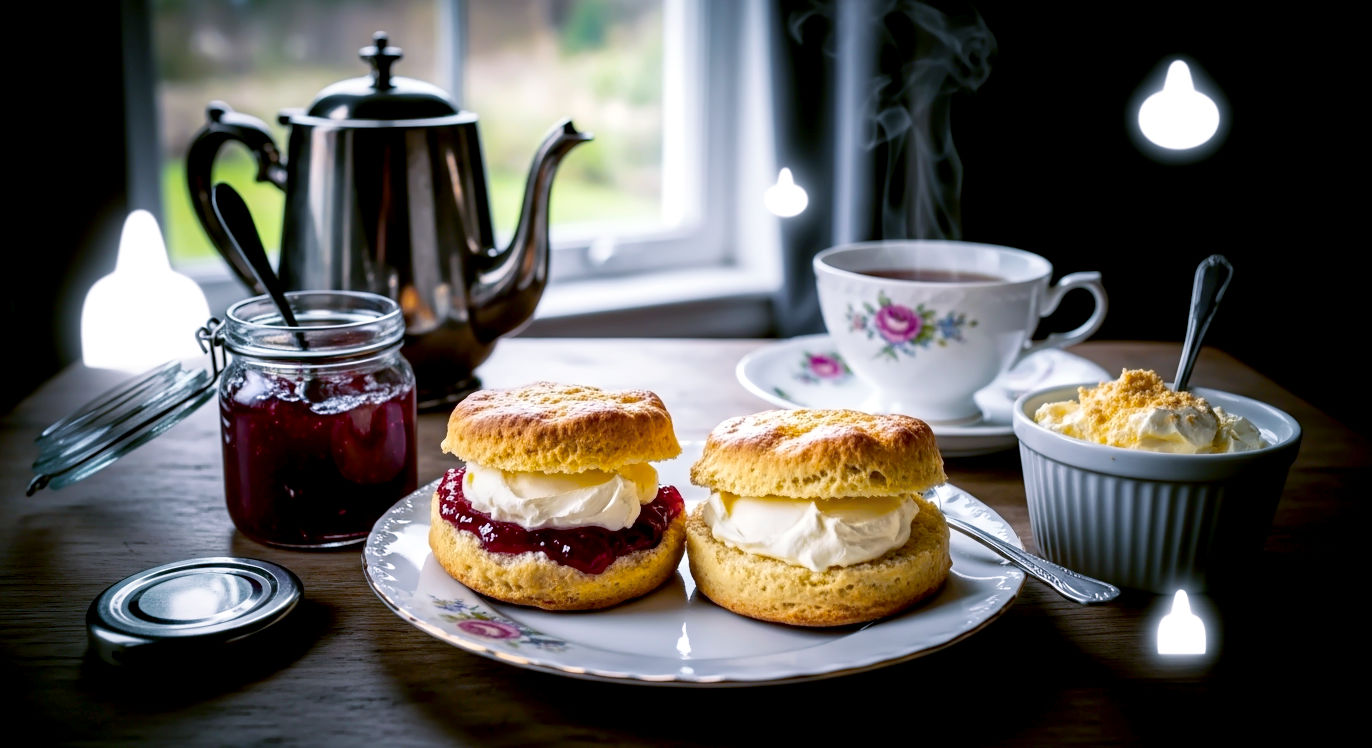The Great British Cream Tea: A Deliciously Definitive Guide
Our definitive guide to the Great British Cream Tea. Explore its origins in a Devon abbey, the fierce Cornwall vs. Devon rivalry, and how to enjoy it properly.

This post may contain affiliate links. If you make a purchase through these links, we may earn a commission at no additional cost to you.
There are few things more quintessentially British than a cream tea. It’s more than just a snack; it’s a ritual, a taste of home, and the centre of one of the nation’s most enduring and passionate culinary debates. Picture it: a warm, fluffy scone, generously slathered with fruity strawberry jam and a dollop of thick, decadent clotted cream, served alongside a steaming pot of freshly brewed tea. It’s a simple pleasure, but one that’s steeped in history, tradition, and fierce regional pride.
But this beloved treat comes with a crucial question, one that has divided families, friends, and entire counties for generations: what goes on the scone first, the jam or the cream?
It sounds trivial, but in the heartlands of the cream tea—Devon and Cornwall—it’s a matter of identity. Get it wrong, and you might get a playful telling-off. Get it right, and you’ll earn a nod of respect. In this guide, we’ll delve into everything you could ever want to know about this iconic British institution. We’ll uncover its surprising origins in a medieval monastery, deconstruct its delicious components, and, of course, tackle the great jam-versus-cream debate head-on. So, put the kettle on, and let’s get started.
What Exactly Is a Cream Tea?
First things first, let’s clear up some common confusion. A cream tea is not the same as an Afternoon Tea, although they’re often enjoyed at a similar time of day.
- A Cream Tea is beautifully simple. It consists of scones, clotted cream, and strawberry jam, served with a pot of tea. That’s it. No sandwiches, no tiny cakes, no fuss. It’s the star of its own show.
- An Afternoon Tea is a far grander affair. It’s a three-tiered feast that typically includes a selection of finger sandwiches (crusts cut off, of course), followed by scones with jam and cream, and finished with a top layer of exquisite cakes, pastries, and fancies. It was popularised by Anna, the Duchess of Bedford, in the 1840s as a way to bridge the long gap between lunch and dinner.
- High Tea, despite its name, was traditionally a working-class meal. It was a hearty, hot evening meal served with a mug of strong tea, often including things like pies, meats, cheese on toast, or fish.
So, while an Afternoon Tea includes a cream tea course, a cream tea stands alone as a simpler, yet no less delightful, experience. Its beauty lies in its focus on three perfect ingredients.
A Tale of Two Counties: The Great Scone Debate
At the heart of the cream tea tradition lies a fierce but friendly rivalry between the neighbouring counties of Devon and Cornwall. The disagreement centres on one simple thing: the order of assembly. How you top your scone says everything about where your loyalties lie.
The Cornish Method: Jam First
In Cornwall, the scone is a vessel for the jam, with the cream acting as the crowning glory. The logic is simple and practical.
- How it’s done: The warm scone is split, and a generous layer of strawberry jam is spread across each half. A thick dollop of clotted cream is then spooned on top.
- The argument: Cornish tradition holds that this is the only sensible way. The jam acts like butter, sinking into the warm scone. The cream, being the most luxurious ingredient, sits proudly on top, a final flourish of indulgence. It’s also argued that you can get more cream on this way, and who would argue with that? Plus, it’s just plain wrong to treat clotted cream like butter.
This method is so ingrained in Cornish identity that you’ll see it advertised as the “Cornish Cream Tea.”
The Devonian Method: Cream First
Head east across the River Tamar into Devon, and the rules are completely reversed. Here, cream is king, and it forms the foundation upon which the jam sits.
- How it’s done: The scone is split, and each half is covered with a thick blanket of clotted cream first. A spoonful of strawberry jam is then placed gently on top.
- The argument: The people of Devon (or Devonians) argue that clotted cream should be treated like butter, providing a rich, creamy base. The jam is the sweet topping. Proponents say this method is neater, preventing the jam from sliding off a mound of cream. It allows the flavour of the cream to be the first thing you taste. It’s known, naturally, as the “Devonshire Cream Tea.”
So, Who Is Right?
Here’s the secret: nobody is. There is no historical law or ancient decree that says one way is correct. Both methods are delicious, and both have been practised for generations in their respective regions.
The rivalry is a cherished part of the tradition, a fun and entirely harmless debate that adds a little spice to a sweet treat. The truth is, the “correct” way to eat a cream tea is whichever way you enjoy it most. Though it’s always wise to follow the local custom if you’re visiting Devon or Cornwall!
The Delicious History of the Cream Tea
While the Devon-Cornwall rivalry is a relatively modern phenomenon, the origins of the cream tea itself can be traced back over a thousand years to, perhaps surprisingly, a group of monks in Devon.
Tavistock Abbey’s 11th-Century Snack
The story begins in the 10th century at Tavistock Abbey, a Benedictine monastery in Devon. After the abbey was ransacked and badly damaged by Vikings in 997 AD, its restoration was a huge undertaking. According to local historical records, the monks rewarded the local workers who helped rebuild the abbey with a fortifying snack. They served them bread topped with a rich, clotted cream made from the milk of their own cows, and a sweet preserve, likely made from local berries.
This simple combination of bread, cream, and jam is widely considered to be the earliest ancestor of the cream tea we know today. It was a taste of things to come, but it would take a few centuries—and the arrival of scones and tea—for the tradition to fully form.
The Arrival of Tea and Tourism
The cream tea as we know it truly took off in the mid-19th century. This was thanks to a perfect storm of social and economic changes.
Firstly, tea became more affordable and fashionable. What was once a luxury for the very wealthy started to become a staple in British households. Secondly, the Victorian era saw the birth of tourism. The development of the railway network, particularly the Great Western Railway, made it possible for city dwellers to escape to the seaside resorts and picturesque countryside of the West Country.
Suddenly, places like Devon and Cornwall were flooded with holidaymakers looking for a taste of local life. Clever hoteliers and café owners started serving this delightful local speciality—scones with clotted cream and jam—alongside the nation’s favourite new drink, tea. The “cream tea” was born and quickly became a must-have holiday experience, cementing its place in British culture forever.
Deconstructing the Perfect Cream Tea: The Holy Trinity
A cream tea is only as good as its parts. The magic lies in the perfect balance of three key ingredients, each with its own story.
1. The Scone: The Fluffy Foundation
The scone is the warm, welcoming heart of the cream tea. Its name is thought to derive from the Stone of Destiny (or Scone) in Scotland, where Scottish kings were once crowned. The earliest scones were large, oat-based griddle cakes, very different from the light, fluffy rounds we enjoy today.
The modern scone, made with flour and raised with baking powder, became popular in the 19th century. For a cream tea, the scone should be:
- Freshly baked: A warm scone is non-negotiable. It allows the jam or cream to melt ever so slightly.
- Light and airy: The texture should be soft and crumbly, never dense or cakey.
- Plain or Fruited? This is another minor debate. Traditionalists often prefer a plain scone to let the cream and jam shine. However, a fruit scone, studded with juicy sultanas, is equally popular and adds another layer of flavour and texture.
2. The Clotted Cream: The Golden Crown
Clotted cream is the soul of a cream tea. It’s not whipped cream or double cream; it’s something far more special. This incredibly thick, rich, and slightly nutty cream has a beautiful golden crust on top, formed during the cooking process.
It’s made by gently heating unpasteurised full-fat cow’s milk in a shallow pan for many hours, then leaving it to cool slowly. During this time, the cream rises to the surface and “clots,” forming that distinctive crust.
Cornish Clotted Cream is so unique that it has been awarded Protected Designation of Origin (PDO) status, just like Champagne or Parma Ham. This means that for it to be called Cornish Clotted Cream, it must be produced in Cornwall from the milk of Cornish cows and have a minimum fat content of 55%. This protected status is a source of immense pride for Cornish producers.
3. The Strawberry Jam: The Sweet Jewel
While other jams can be used, strawberry jam is the undisputed classic choice for a cream tea. Its slight sharpness and fruity sweetness perfectly cut through the richness of the clotted cream.
The best jam for a cream tea is a high-quality conserve, one that is packed with whole or large pieces of fruit. It should have a vibrant red colour and a fresh, summery flavour. The rise of the strawberry as the go-to fruit coincided with the popularisation of the cream tea in the 19th century, when strawberry cultivation became more widespread in Britain.
And to Drink? A Proper Pot of Tea
Of course, it wouldn’t be a cream tea without the tea. A robust, full-bodied black tea is the traditional accompaniment.
- English Breakfast Tea is a classic choice, its strength holding up well against the rich scone.
- Earl Grey, with its fragrant hint of bergamot, offers a more aromatic alternative.
Whatever you choose, it should be brewed properly in a teapot and served with milk (and sugar, if you wish). The tea acts as the perfect palate cleanser, washing down the sweetness and getting you ready for the next delicious bite.
Cream Tea Etiquette: How to Enjoy It Like a Local
While there are no strict, formal rules, there are a few cherished customs that will help you enjoy your cream tea in the traditional way.
- Break, Don’t Cut: A scone should never be sliced in half with a knife. Instead, break it apart gently with your hands. You should feel a satisfying split along its middle.
- Assemble One Half at a Time: Don’t make a scone sandwich! Prepare and eat one half of the scone completely before moving on to the next. This keeps things neat and allows you to savour each bite.
- Use Your Fingers: You don’t need a knife and fork to eat the scone. It’s a hands-on experience.
- Stir Your Tea Gracefully: To avoid clanking your spoon against the cup, stir your tea with a gentle back-and-forth motion (from 6 o’clock to 12 o’clock), not in a vigorous circular motion. When you’re done, place your spoon on the saucer, not in the cup.
Beyond the West Country: Cream Tea Across Britain
While Devon and Cornwall remain the spiritual home of the cream tea, this wonderful tradition has spread to every corner of the British Isles and beyond. Tea rooms from the Scottish Highlands to the Kent coast proudly serve their own versions.
This has led to some interesting variations:
- Savoury Cream Teas: A modern twist on the classic, these often feature cheese scones served with cream cheese and a tangy chutney instead of jam.
- Thunder and Lightning: A lesser-known Cornish variation that swaps the strawberry jam for golden syrup or black treacle. It’s a beautifully simple and intensely sweet alternative.
- Different Jams and Scones: You might find lavender scones, lemon and poppy seed scones, or even chocolate chip scones, served with a whole range of jams like raspberry, blackcurrant, or gooseberry.
While these can be delicious, for the true, authentic experience, nothing beats the classic combination of a plain or fruit scone with strawberry jam and clotted cream.
Conclusion: A Tradition Steeped in Joy
The cream tea is far more than just its ingredients. It’s a moment of pause in a busy world. It’s the taste of a British summer holiday, a comforting treat on a rainy afternoon, and a celebration of regional heritage.
And what of the great debate? Jam first or cream first? In the end, it doesn’t really matter. The rivalry is part of the fun, a story we tell ourselves over a pot of tea. The most important rule of a cream tea is simply to enjoy it. So whether you’re a proud Devonian, a steadfast Cornish traditionalist, or a neutral observer, take a moment to savour this simple, perfect, and utterly British delight.
Further Reading
For those interested in diving deeper into the history and culture of British food and tea, here are some excellent resources:
- The National Trust: Many of their historic properties feature wonderful tea rooms serving traditional cream teas. Their website often has articles on the history of British food.
- The Tea and Coffee Trade Journal: For in-depth articles on the history and trade of tea.
- The Cornwall and Devon Record Offices: For those interested in primary sources and local history related to food traditions in the West Country. Cornwall Records | Devon Records






